There are always negative costs associated with development and these are often shifted to the poor, who derive no benefit.
For the past two decades Redbank Mine has been leaking insidious copper sulphide into the waterways of the southwest Gulf of Carpentaria, slowly poisoning Garawa country.
The contamination is so bad that you can even see the strangely beautiful bluey-green of the toxic waterways from space.
It’s clearly visible in satellite imagery, right where Savannah Way crosses Hanrahan’s Creek in the Northern Territory, about 40 kilometres from the Queensland border.
What you can’t see from space is kilometre after kilometre of lifeless water. With a Ph level close to battery acid, it’s entirely devoid of marine life.
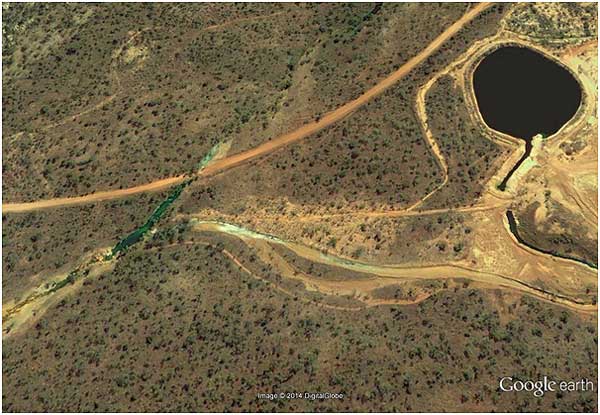
In places, the sandy soil that once gave life to riparian habitats is vacant.
River Red Gums and Melaleucas whose roots have found the poisonous water as it seeps underground are wasted.
The level of contamination throughout the region is so high that tainted waters have been recorded over 40 kilometres away from the mine site.
Unfixed, the pernicious waters will continue to make their way further downstream into Queensland before they eventually threaten coastal floodplains.
The threats to biodiversity from contaminated waters in the surrounding Wollogorang Ranges are also high.
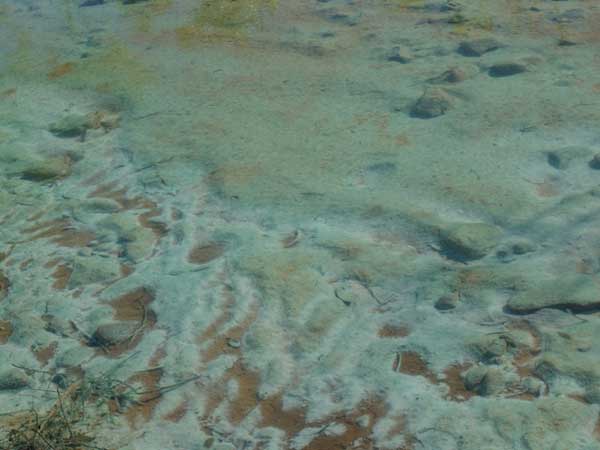
Six threatened species occur within the region, with the Gouldian Finch and the critically endangered endemic Carpentarian Rock-rat found in close vicinity to mine site.
For Garawa people the creeks and streams within the region aren’t just water and food provisioning resources, they form a complex of interconnected sacred sites that are intrinsic to Garawa cultural, spiritual and ceremonial life.
Copper mining in Garawa Country began in the early 20th century, soon after settlers ‘dispersed’ the Indigenous population with their guns.
Redbank Mine has never been an economic success. For almost 50 years it was a one-man show before changing hands numerous times.
Operations cranked up around 1994 when 170,000 tonnes of ore was processed at the site.
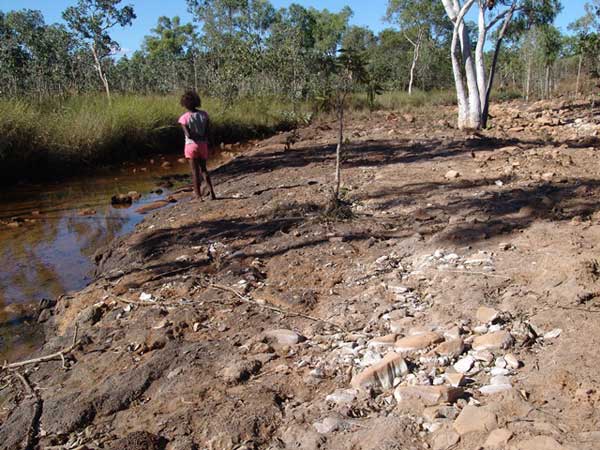
But this short burst of activity ended just two years later when copper prices fell. The mine was closed and placed in what is called care and maintenance mode.
This involved an estimated 54,000 tonnes of partially treated and acid forming material, including vat residues and unsecured waste rock piles, being left on site along with unengineered and poorly sealed tailing facilities that allow affected waters to bleed underground.
The massive stockpile left exposed to the monsoonal rains for 17 years has contributed significantly to the legacy issues that the Garawa people now face.
A recent report by the Northern Territory Environmental Protection Authority (NTEPA) blames ‘the regulatory system in the 1990s [that]allowed mining to commence prior to approval of Environmental Management Plans’.
Despite ‘regulatory changes and improvements’ in environmental assessment processes for mining since the 1990s, the NTEPA points to weaknesses in legislative processes where ‘regulators have not been able to hold operators to account or effectively address environmental risks’.
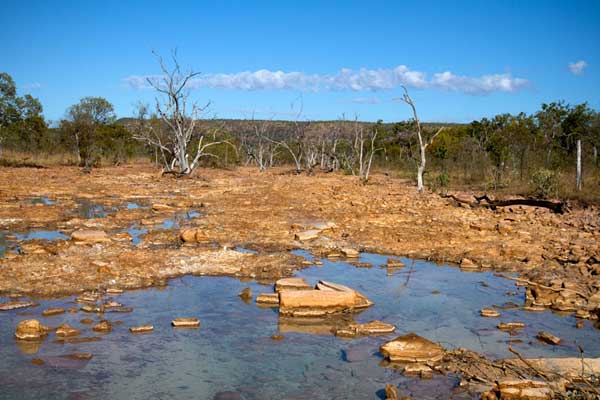
Environmental compliance through market mechanisms has failed. The security bond paid to the NT Government by the mining company to ensure rigorous environmental management was such a pittance that there has never been any real incentive for the mine’s owners to comply.
Garawa people, who have a native title claim over the area, are long sickened by the ongoing damage to their country and culture.
Increasingly frustrated that there is seemingly no one who will take responsibility for the mess and fix the problem, they began to agitate for the NT Government to step in and stop the contamination.
In September 2013 they managed to get the NT Minister for Mines and Energy, Willem Westra van Holthe, along with the Minister for Lands, Planning and the Environment, Peter Chandler, to visit and see the poisoned waters and dying landscape for themselves.
After inspecting the area, Westra van Holthe told Garawa people that remediation of Redbank Mine was a priority issue for his government.
He promised them that it would be ‘a personal priority to fix the problem’, before announcing his intention to apply funds from the newly created Mining Remediation Fund — raised by a one per cent levy on all environmental rehabilitation security bonds from October 2013 and estimated to bring over $6 million per annum to government coffers — to fix the contamination problem.
He also invited Garawa representatives to participate in the Redbank Mine Working Group that he would establish to serve as a consultative forum to work collaboratively towards remediation of the region.
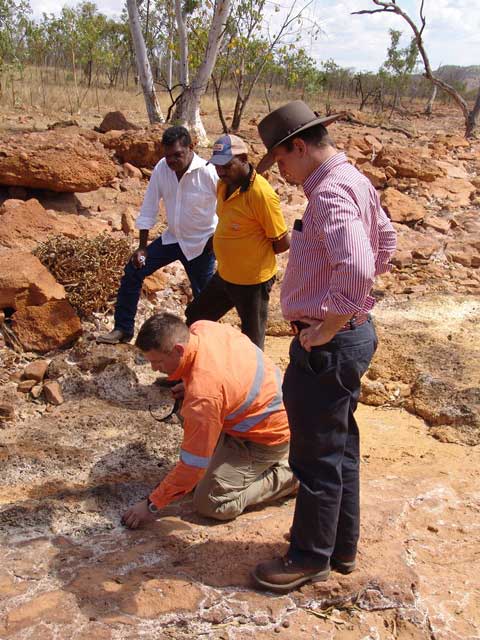
Garawa people liked what they heard. At last someone was taking responsibility and something was going happen.
But then, on 23 December 2013, only two months after the Ministers had fronted Garawa people and made promises, the NTEPA issued Redbank Mine a two-year Waste Discharge Licence to release waste water from the mine into Hanrahan’s Creek; an action that Garawa see as further exacerbating the contamination problem.
Garawa people petitioned Westra van Holthe, asking him to review the Waste Discharge Licence decision and raising concerns about his lack of consultation prior to issuing the licence.
Westra van Holthe responded, telling them he considered the issuing of the discharge licence as pragmatic. His thinking, restated by the NTEPA, is that “little can be done in the short-term to improve the quality of ground and surface water leaving the site, particularly over the 2013-14 Wet Season”.
What the NTEPA has done by issuing Redbank Mine with the licence is hand-back responsibility to Redbank Copper Limited, the current owners of the mine, “to develop and implement a site remediation plan”, something that has been unachievable since open-pit mining began in the mid-1990s.
Despite the goodwill made at the September 2013 meeting, and assurances given to Garawa people that the working group would be consultative, Westra van Holthe rebuffed their concerns about his lack of consultation, telling them he had no statutory obligation to do so.
This experience has left a foul taste in the mouths of Garawa people. Their initial fear that the Working Group was nothing more than a talk-shop designed to draw them in and deliver no real outcome suddenly rang true.
To show their disgust with the NTEPA’s unilateral decision to award the negligent mine with a Waste Discharge Licence they walked out of the most recent meeting.
Redbank Copper Limited is of the view that restarting the mine is the best option.
Once the mine is operational, funds can go to remediation work. But this is a long shot.
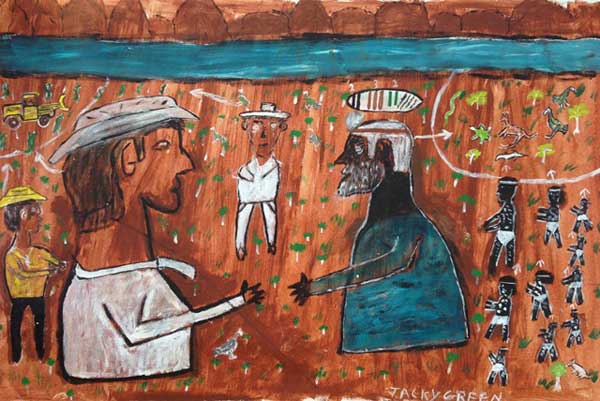
Recent attempts by the company to raise capital by issuing shares to restart mining have come to nothing.
If restarting the mine did succeed – and it’s highly unlikely with Redbank Copper Limited’s shares trading on the Australian stock market at the rock-bottom price A$0.002 – there remains great doubt that Redbank Copper Limited will accept responsibility for the downstream contamination that occurred before it took over the mine in 2006.
Initial remediation costs were estimated to be in the vicinity of $100 million. But this was recently reduced to around $10 million.
As Garawa see it, it’s a small cost considering how much country is at risk from the toxic flow.
They want Minister Westra van Holthe to show leadership and act. They want him to stick to the promise he made to them in September 2013 and use the Mining Remediation Fund to fix the problem before another wet season arrives and washes even more of the insidious copper sulphide into their country.
What Garawa people struggle to understand is, why is it so easy for the NT Government to make over $23 million available to subsidise mining companies’ exploration costs while it remains lead-footed to draw on the Mining Remediation Fund to fix a major environmental disaster that’s been two decades in the making and gets bigger and more deadly each year?
* Dr Seán Kerins is a researcher with the Centre for Aboriginal Economic Policy Research, at the Australian National University in Canberra. You can learn more about the struggles of the Garawa Traditional Owner’s here.
Donate To New Matilda
New Matilda is a small, independent media outlet. We survive through reader contributions, and never losing a lawsuit. If you got something from this article, giving something back helps us to continue speaking truth to power. Every little bit counts.



